
Al-Milaha fi Maqala
Your Path to Deeper Insight
- Countries of the World
- Cities and provinces
- Complete Cooking Recipe Index
- Prophets' Stories
- All Countries of the World
- List of surahs in the Holy Qur'an
- Population of world countries by country
- Zip code in Jordan
- Traffic signs in Jordan
- List of world capitals
- International Calling Codes
- Al-Quran Recitations mp3
- List of currencies of the world
- Car Brand Logos and Names
- Jordanian Cuisine Guide
- Country codes names
- 6 Evergreen Content Topics
- World time zones by country
- Country flags of the world with images and names
- List of countries and dependencies by area
- List of countries and dependencies by population
Ajloun, Jordan: A Citadel of History and Forest Reserve
About Ajloun Governorate
- Ajloun Governorate (alternative spelling Ajlun Governorate) (Arabic: محافظة عجلون) is one of the governorates of Jordan, located north of Amman the capital of Jordan. Ajloun Governorate has the fourth highest population density in Jordan (after Irbid, Jerash, and Balqa Governorates) with a population density of 350.1 people/km2 (2012 estimate). It is bordered by Jerash Governorate from the south east and Irbid Governorate from the north and west.
- The town of Ajloun is dominated by a twelfth century fortress, a very good example of Islamic military architecture. Called Qal 'at al-Rabad, the fortress was built in the late 12th century by Izz al-Din, Saladin's nephew and one of his generals. It is surrounded by a moat dug out of solid rock.
- Along with Balqa and Karak governorates, Ajloun was formerly a united sanjak of the Ottoman Empire.
Geographical location
Ajloun Governorate is located in the northwestern corner of the Jordanian capital, Amman, at a distance of (76) km. It is bordered to the north and west by Irbid Governorate (Jordan Valley region), which is 32 km away, to the east by Jerash Governorate, which is 25 km away, and to the south by Balqa Governorate, which is 72 km away.
Ajloun Governorate (Jordan) Administrative Divisions
Ajloun Governorate is divided into two main districts (Departments/Liwaa's):1) Ajloun District (Liwaa' Qasabat Ajloun)
This district includes the governorate's capital and the following towns and villages:- Ajloun (The Capital), Anjara, Ain Janna, Al Hashimiyya, Al Wahadnah, Halawa, Deir Al Samadiyya Al Shamali (North Deir Al Samadiyya), Deir Al Samadiyya Al Janoubi (South Deir Al Samadiyya), Khushaiba Al Fawqa, Al Jabal Al Akhdar, Al Shakkara, Al Fakhira, Mahna, Ishtafina, Al Tayyara, Um Al Yanabee', Al Sakhna, Al Hanash, Khirbet Al Souq, Al Zira'a, Kufr Al Durra, Al Jibb, Al Hazzar, Al Zayzafouna, Al Sarabees, Um Al Khashab, Khallet Salem, Khallet Warda, Al Naqab, Uweimer, Al Za'tara, Abu Al Zaytoon, Listib, Al Safsafah, Al Sawwan.
2) Kufranjah District (Liwaa' Kufranjah)
This district includes Kufranjah and the following towns and villages:- Kufranjah, Rajeb, Balas, Al Safina, Ain Al Bustan, Al Harith, Dahous, Thughrat Zubaid, Al 'Amriyya, Al Birkeh, Um Al Raml, Maryameen, Khallet Al Samra, Ka'b Al Maloul, Al Shatura, Al Mushairfa, Al 'Uqdah, Nimr, Al Nawba, Sakhra, Abbien, Abbaleen, Samta, Munif, Deir Al Burak, Khirbet Farra, Irjan, Ba'oun, Rasoun, Awsara, Sana'ar, Al Marjam, Usaim, Beer Al Daliyyah.
Ajloun's Climate and Weather: Mountain Moderation and Forest Richness
Ajloun Governorate enjoys a unique and temperate climate, belonging to the Mediterranean region, due to its location on high mountain ranges and its dense forest cover.- Summer: The climate is moderate and pleasant during the summer, with the average temperature reaching about 25∘C (77∘F), making it an attractive summer resort and destination.
- Winter: The climate is cold and humid. Ajloun is considered one of the areas in the Kingdom with the highest amount of rainfall and snowfall, which significantly contributes to feeding its valleys and maintaining the density of its green forests.
Ajloun Landmarks and Sites: Historical Authenticity and Natural Beauty
Ajloun Governorate is characterized by a unique blend of deep historical heritage, stunning natural landscapes, and modern recreational destinations, making it one of the most important tourist attractions in Northern Jordan.1. Main Historical and Archaeological Sites
Ajloun Castle (Qal'at Ar-Rabad)
- A strategic Islamic fortress built during the Crusader period (1184–1185 CE) by order of Izz al-Din Usama, one of Salah ad-Din al-Ayyubi’s commanders.
- Located atop Mount Auf, the castle was intended to protect the country from the Crusaders, control local iron mines, and secure major trade routes between Jordan and Syria.
- It is considered one of the best-preserved examples of Arab military architecture from the Middle Ages, offering spectacular panoramic views of the Jordan Valley and Northern Jordan.
Historical Mosques
- Ajloun Grand Mosque: One of the oldest historical mosques in Jordan, dating back to the Ayyubid and Mamluk eras in 1247 CE. It is situated in the center of Ajloun city.
- Listib Archaeological Mosque: Located in the village of Ishtafina, this is considered one of the oldest historical mosques, with its history tracing back to the Umayyad era.
Tell Mar Elias (Site of Listib Church)
- An archaeological hill located northwest of Ajloun, containing the ruins of two ancient churches.
- It is traditionally believed to be the birthplace of the Prophet Elijah (Mar Elias) and is recognized as an annual Christian pilgrimage site.
Other Archaeological Sites
- Tell Halawa (Al-Tantour): An archaeological site in Halawa where the remains of a Byzantine church were uncovered, highlighting the historical depth of the governorate.
- Ajloun Archaeological Museum: Located inside Ajloun Castle, it displays a collection of artifacts, mosaics, and stone inscriptions dating back to various periods, from the Bronze Age to the Mamluk era.
2. Religious Sites and Shrines of Prophets
Ajloun includes important religious destinations for both Muslims and Christians:- Our Lady of the Mount Church (Anjara): A sacred cave declared a Christian pilgrimage site by the Vatican in 2000. It is believed that the Virgin Mary and Christ passed through this location.
- Al-Khidr Shrine (Maqam Al-Khidr): An important religious site located in Ajloun.
- Other Religious Shrines: Such as Maqam Sidi Bader, Maqam Ali Al-Momani, and Maqam Mahboub in various areas of the governorate.
3. Natural and Recreational Sites
Ajloun is known for its green, mountainous nature, offering multiple options for ecotourism and recreation:- Ajloun Forest Reserve (Ajloun Nature Reserve): Covering an area of 13 km2 and managed by the Royal Society for the Conservation of Nature (RSCN). It features multiple trails for hiking through oak forests, offers tourist lodges, and promotes local handicrafts.
- Ajloun Cable Car (Ajloun Cable Car): A modern recreational landmark with a track extending 2.5 km. It provides spectacular panoramic views of the forests and mountainous regions, and includes service areas and restaurants.
- Kufranjah Valley (Wadi Al-Tawaheen - Valley of the Mills): A valley rich in flora, fruit trees (like walnuts and pomegranates), and springs. It is famous for the remains of old water mills and other archaeological sites.
- Rajeb Valley and Azeeq Waterfalls: Pristine natural areas offering opportunities for picnicking and enjoying the beauty of the perpetually flowing valleys.
The Jordanian Cuisine in the North: Ajloun and the Legacy of the Mountain Flavor
The cuisine of Ajloun and the Northern regions of Jordan is distinguished by its rich rural heritage, relying on the land's bounty—olives, wheat, wild herbs, and fresh dairy products—which imparts a deep, seasonal flavor and nutritional richness to the dishes.First: Main and Substantial Dishes
These dishes form the backbone of the Northern Jordanian table, being rich and prepared with grains, dairy, and local ingredients.- Al-Makmoura:Al-Makmoura
 (Famous Ajloun Dish): It is a main traditional dish famous in the villages of Northern Jordan (Irbid and Ajloun). It is a thick, large pie made of layers of flattened dough. This pie is stuffed with large quantities of chopped onions, pieces of chicken or meat, and generously cooked with virgin olive oil and sumac. Al-Makmoura is baked over low heat for a long period (which can last for hours), making it a winter feast dish and a symbol of generosity at major events.
(Famous Ajloun Dish): It is a main traditional dish famous in the villages of Northern Jordan (Irbid and Ajloun). It is a thick, large pie made of layers of flattened dough. This pie is stuffed with large quantities of chopped onions, pieces of chicken or meat, and generously cooked with virgin olive oil and sumac. Al-Makmoura is baked over low heat for a long period (which can last for hours), making it a winter feast dish and a symbol of generosity at major events. - Al-Rshoof: A nutritious and warming winter soup, based on cooked fermented yogurt (usually *Laban Ra'ib* or *Shneeneh*) with *Jarisha* (coarse cracked wheat) and lentils. It is often served with crumbled *Shrak* bread mixed into it, making it an ideal dish for Ajloun's cold climate.
- Al-MansafAl-Mansaf
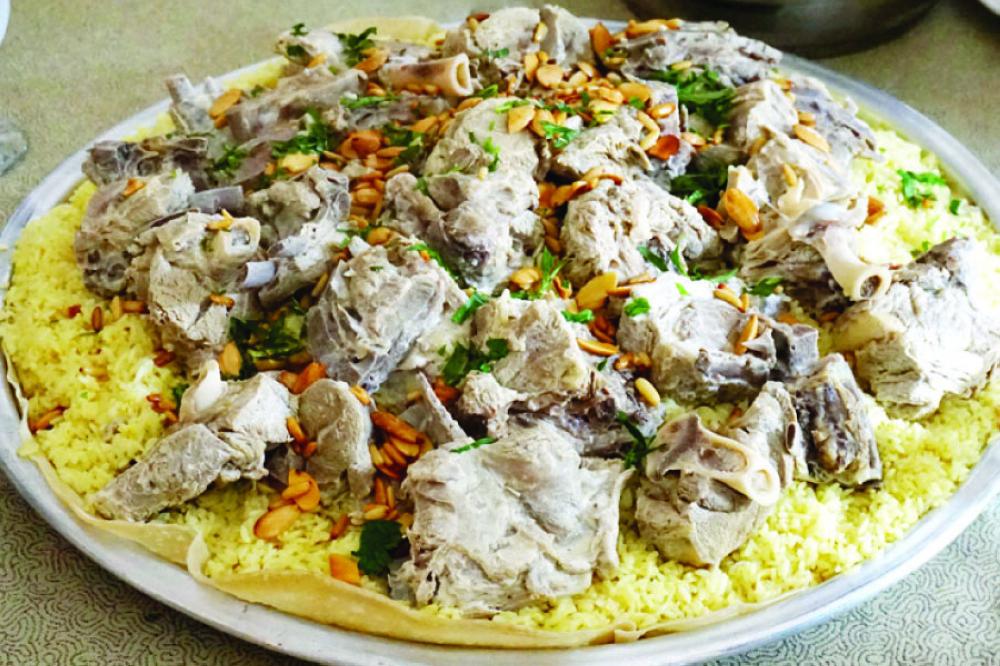 Al-Shamali (Rural Mansaf): It differs from the traditional Karak Mansaf; it sometimes uses fresh *Shneineh* (buttermilk) or *Laban Ra'ib* (strained yogurt) instead of the solid *Jameed* (dried yogurt), which gives it a milder, less tart flavor. It is cooked with lamb or veal meat and served over rice and local bread.
Al-Shamali (Rural Mansaf): It differs from the traditional Karak Mansaf; it sometimes uses fresh *Shneineh* (buttermilk) or *Laban Ra'ib* (strained yogurt) instead of the solid *Jameed* (dried yogurt), which gives it a milder, less tart flavor. It is cooked with lamb or veal meat and served over rice and local bread. - Al-Maqluba:Al-Maqluba
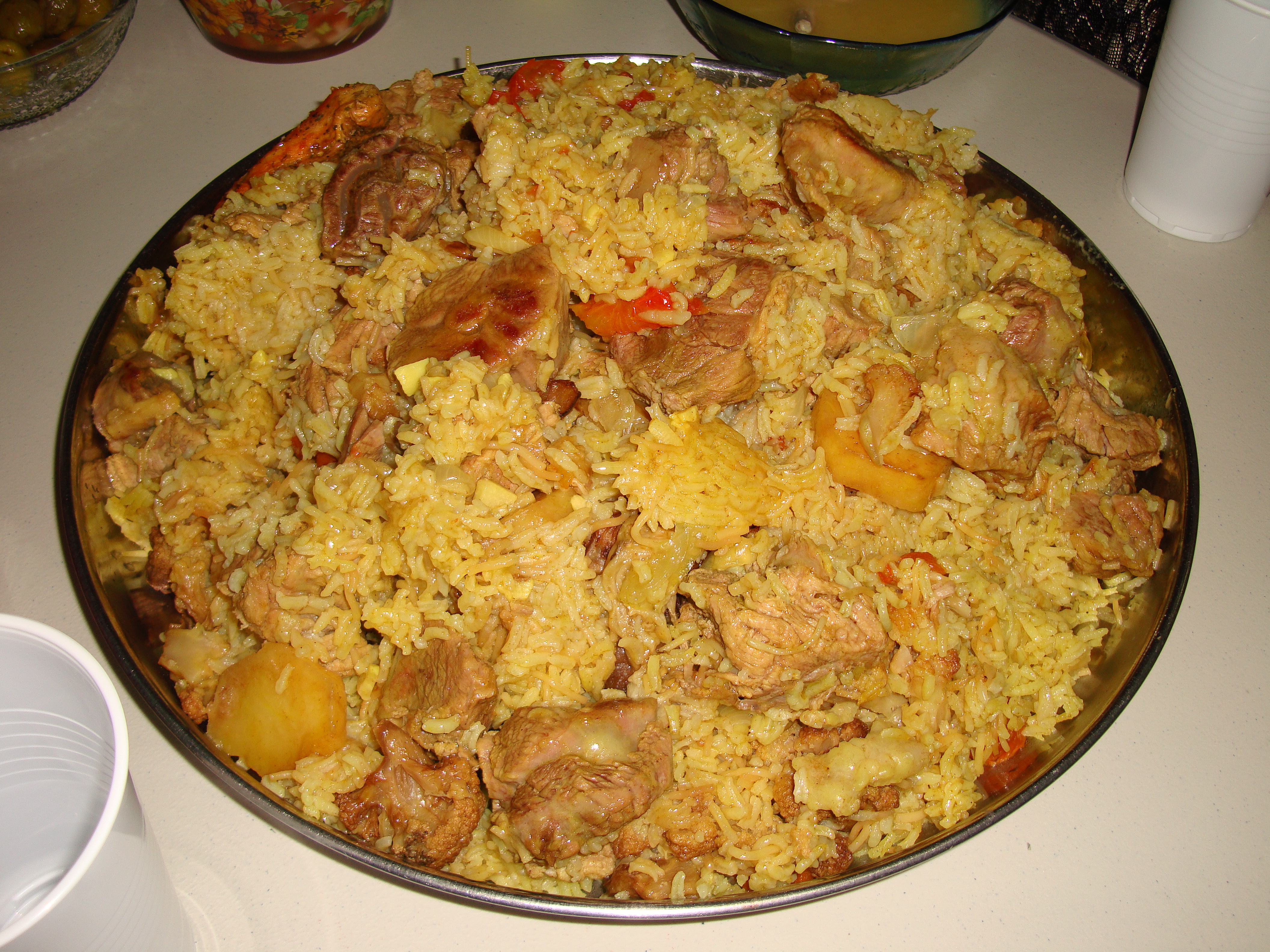 A very popular dish, consisting of rice cooked with pieces of meat (often chicken) or fried vegetables such as eggplant, cauliflower, or potatoes. The dish is flipped upside down when served, hence its name (Maqluba means 'upside down').
A very popular dish, consisting of rice cooked with pieces of meat (often chicken) or fried vegetables such as eggplant, cauliflower, or potatoes. The dish is flipped upside down when served, hence its name (Maqluba means 'upside down'). - Al-Matabiq (Stuffed Bread): Local bread baked on a *Saj* (metal dome) or in a *Taboun* (clay oven), stuffed before baking with various fillings such as onions and sumac, fresh wild thyme, or minced meat.
- Al-MaftoulAl-Maftoul
 (Northern Couscous): A dish characterized by hand-rolled wheat grains (in the form of small balls) steamed and served with chicken broth, vegetables, and chickpeas.
(Northern Couscous): A dish characterized by hand-rolled wheat grains (in the form of small balls) steamed and served with chicken broth, vegetables, and chickpeas.
Appetizers and Popular Daily Foods in Ajloun
- Galayet BandoraGalayet Bandora
 (Fried Tomatoes): Fried tomatoes cooked with onions, olive oil, salt, and chili pepper. It can be served with rice but is more commonly eaten with bread in Jordan, and is essential for all segments of the population across all governorates.
(Fried Tomatoes): Fried tomatoes cooked with onions, olive oil, salt, and chili pepper. It can be served with rice but is more commonly eaten with bread in Jordan, and is essential for all segments of the population across all governorates. - FalafelFalafel
 : Balls made from fried chickpea flour and Middle Eastern spices. It is dipped in every mezze, especially hummus. Jordanian falafel balls tend to come in smaller sizes.
: Balls made from fried chickpea flour and Middle Eastern spices. It is dipped in every mezze, especially hummus. Jordanian falafel balls tend to come in smaller sizes. - Hummus and Fuul MedamesHummus and Fuul Medames
 : Foods usually served for breakfast, especially on Fridays, and also offered as appetizers for lunch and dinner.
: Foods usually served for breakfast, especially on Fridays, and also offered as appetizers for lunch and dinner.
Second: Ajloun's Treasures of Wild Herbs and Plants
Ajloun is distinguished by its mountainous environment that yields treasures of seasonal wild herbs, forming unique and healthy dishes.- Cooked Akkoub: A seasonal thorny plant collected in early spring. It is meticulously cleaned and peeled. It is cooked with fermented yogurt (the traditional method) or with olive oil and lemon. It is considered a main seasonal delicacy in Ajloun.
- Khobbeizeh (Mallow): Fresh mallow leaves are cooked with olive oil, garlic, and onions, and seasoned with lemon. A healthy and widespread dish in its season.
- Louf (Arum): A wild plant that requires a special cooking method (repeated boiling or soaking) to reduce its bitterness and acidity, often cooked with meat.
- Qurseedeh: A popular dish prepared from coarse cracked wheat or bulgur, cooked with yogurt or clarified butter (*Samn Baladi*).
Third: Baked Goods and Dairy Products
These varieties reflect the simplicity of ingredients and reliance on rural preparation methods.Baked Goods:
- Taboun / Saj Bread: The foundation of Northern cuisine. It is baked in a clay oven (*Taboun*) or on a *Saj* (metal dome), and eaten with oil, thyme (*Za'atar*), and yogurt.
- Al-Ma'rouk Al-Ajlouni: A type of bread that can be sweetened (with anise and sugar) or savory (with onions and sumac). It is traditionally baked during holidays and social occasions.
Dairy Products:
- *Labanah Baladiyyah* (Rural Labaneh): Made from churned yogurt (*Laban Ra'ib*), characterized by its creamy texture and fresh, slightly tart flavor.
- *Shneineh* (Buttermilk): A liquid, refreshing, and sour buttermilk, used for drinking or in cooking *Al-Rshoof*.
- *Samn Baladi* (Clarified Butter): Pure ghee traditionally extracted from goat or sheep milk, and is the basis of the flavor for many Northern dishes (like Al-Makmoura and Al-Lazaqiyyat).
Fourth: Desserts and Distinctive Ingredients
Traditional Desserts:
- Al-Lazaqiyyat: A rural dessert baked on the *Saj* in thin layers (similar to *Qatayef* batter), generously drizzled with *Samn Baladi* and sugar or honey.
- Al-'Awwamah and Al-Zalabiyya: Fried desserts submerged in *Qater* (sugar syrup).
- 'Eid Bread (*Khubz Al-Eid*): A type of sweetened and spiced cake or bread with anise and fennel, specially prepared for holidays.
- QatayefQatayef
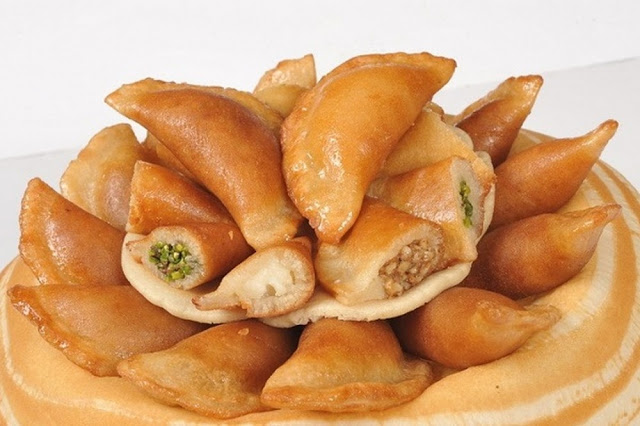 (Qatayef): A unique pancake-shaped stuffed dessert native to the region. It resembles a folded pancake and is traditionally filled with fresh cream (*Qishta*) or ground pistachios. It is a famous dessert primarily consumed during the holy month of Ramadan.
(Qatayef): A unique pancake-shaped stuffed dessert native to the region. It resembles a folded pancake and is traditionally filled with fresh cream (*Qishta*) or ground pistachios. It is a famous dessert primarily consumed during the holy month of Ramadan.
Other Desserts
- BaklavaBaklava
 (Baklava): A rich and delicious pastry made of thin, crispy layers of Phyllo DoughPhyllo Dough
(Baklava): A rich and delicious pastry made of thin, crispy layers of Phyllo DoughPhyllo Dough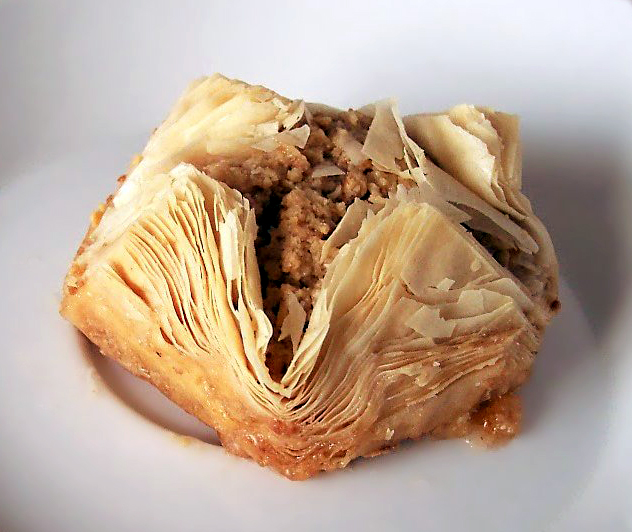 , filled with chopped nuts (often pistachios or walnuts), and generously soaked in honey or *Qater* (simple sugar syrup).
, filled with chopped nuts (often pistachios or walnuts), and generously soaked in honey or *Qater* (simple sugar syrup). - KnafehKnafeh
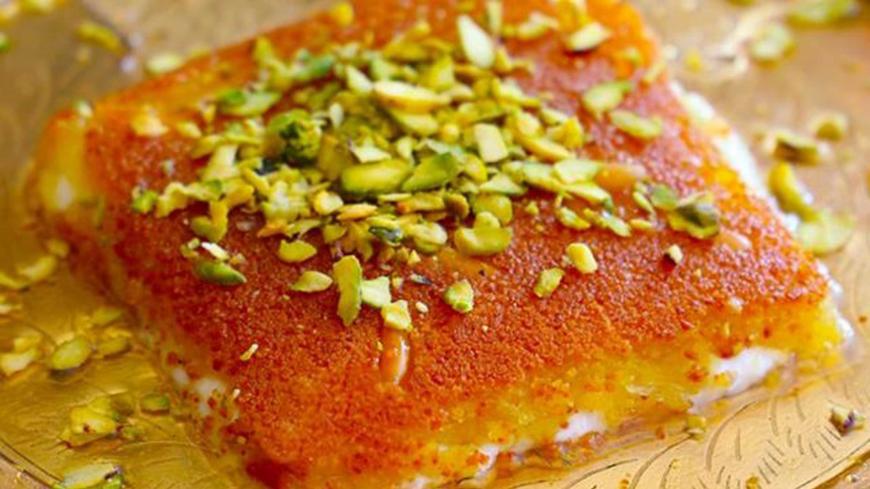 (Knafeh): A famous and distinctive Middle Eastern dessert based on cheese. It consists of coarse *Knafeh* dough or fine semolina strands layered over a layer of soft cheese, then soaked in a sugary syrup often flavored with rose water.
(Knafeh): A famous and distinctive Middle Eastern dessert based on cheese. It consists of coarse *Knafeh* dough or fine semolina strands layered over a layer of soft cheese, then soaked in a sugary syrup often flavored with rose water. - WarbatWarbat
 (Warbat): Thin, triangular pastries made from crispy layers of phyllo, filled with smooth, sweet cream (or custard). Like Qatayef, Warbat is heavily consumed during the holy month of Ramadan.
(Warbat): Thin, triangular pastries made from crispy layers of phyllo, filled with smooth, sweet cream (or custard). Like Qatayef, Warbat is heavily consumed during the holy month of Ramadan.
Distinctive Local Ingredients:
- Ajloun Olive Oil: Famous for its high quality due to the mountainous environment, it is the essential base ingredient for all Northern dishes.
- Wild Thyme (*Za'atar*) and Sumac: These spices are used to flavor bread and salads, and are harvested from the mountains of Ajloun.
- Local Wheat and Lentils: The foundation of winter dishes like *Al-Rshoof* and *Al-Maftoul*.
Area and Population of Ajloun Governorate
Ajloun Governorate is considered one of the smallest governorates in Jordan by area, and it is characterized by a high population density due to the concentration of residents in its limited mountainous regions. According to recent estimates:- Population: The population is estimated at more than 212,500 inhabitants (based on 2023/2024 estimates).
- Governorate Area: Approximately 420 km2 (160 miles2).
- Population Density: High. It is considered the second smallest governorate in Jordan by area after Jerash Governorate.
Summary: Ajloun - Where History Meets Nature and Heritage
Ajloun Governorate combines historical richness through its Ayyubid castle and ancient monuments, natural beauty in its dense forests and green reserves, and authentic heritage in its unique mountain cuisine and genuine northern traditions.
Keywords:
Ajloun Jordan, Ajloun Castle, Ajloun Reserve, Ajloun Cable Car, Ajloun Tourism, Rabad Castle, Mar Elias Hill, Ajloun Forests, Northern Jordan, Makmoura Dish, Rashouf, Akkoub, Ajloun Olive Oil, Ajloun Climate
Ajloun Jordan, Ajloun Castle, Ajloun Reserve, Ajloun Cable Car, Ajloun Tourism, Rabad Castle, Mar Elias Hill, Ajloun Forests, Northern Jordan, Makmoura Dish, Rashouf, Akkoub, Ajloun Olive Oil, Ajloun Climate
This page has been viewed
10733
times


Be the first to comment on this topic!
Leave a Comment